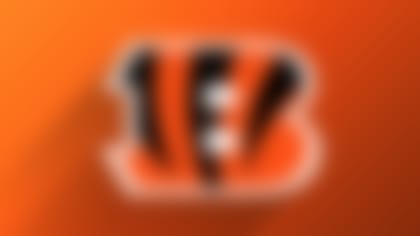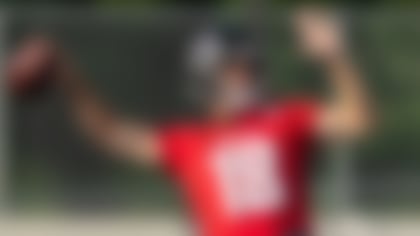With the draft just days away, teams now covet a certain player or two in the first round -- and they must protect their interests in any way they can. Scouts and assistant coaches are often removed from the process so as not to leak the intentions of the club. The real draft board is headed for lock and key, and only the GM and head coach will share its contents with the owner. Then again, sometimes club employees leak false information to send other teams down the wrong path. All is far in love and war. Smart teams know how to posture and create a good smoke screen. It starts with the top team on the board, and this year that's the Detroit Lions.
When I was with the New York Jets, we postured in a few directions when we had the No. 1 pick in the 1996 draft. We wanted the agents representing the top picks to believe we were going to do a pre-draft deal and that it would be a determining factor. The Lions are doing the same thing with the agents representing the top candidates, but in the end they will get their bluff called -- like we did -- and it may really come down to drafting the player they want rather than the most signable prospect.
At the same time, the Lions have to appear to be trying to sell the top pick to move down. This may or may not be a smoke screen. It's getting tougher to trade down from the top five picks, especially if teams are looking for the kind of compensation other teams got years ago.
Mock draft central
Find out how all of our experts think the first round will unfold by checking out their mock drafts. Each mock will be updated as we get closer to the April 25-26 draft. More ...
Keep in mind that the media and fans are not privy to what teams are really going to do. But teams will use the media to create illusions about their intentions. Most outsiders are driven by team needs to decipher what a team may do in the draft, and that is the groundwork for a smoke screen.
In 1993, we had a top-five pick in the first round and wanted to draft Florida State linebacker Marvin Jones. It got out on the street that we were seriously considering Georgia running back Garrison Hearst. The night before the draft, we got a call from the Cardinals saying that they would like to switch spots in the first round. They were only one pick behind us, but they wanted Hearst and so they didn't want us taking him -- or selling the spot to a team below them. We wound up acquiring running back Johnny Johnson from the Cardinals for trading spots, and we had the media to thank for establishing the illusion that we were thinking about Hearst or moving down.
This year, the quarterbacks will cause some maneuvering in the first round. What if the Lions pass on Matthew Stafford? That could make the No. 2 spot (St. Louis) or No. 3 spot (Kansas City) more valuable. It also creates added pressure on other aspects of the first round when it comes to where Mark Sanchez or Josh Freeman may go. Mark my words, in the days leading up to this draft, we will hear that some teams like Sanchez more than Stafford, while still others like Freeman more than either of them. I have talked with a very credible quarterback evaluator who later this week will say that Sanchez is the best prospect, and I know a few clubs listen to his opinion.
Player news in the days leading up to the draft about failed drug tests or a newly discovered injury will also be big factors in the posturing business. Two weeks ago, it was rumored that a number of players failed a drug test; this week a few players will be confirmed. I remember going to Warren Sapp's hotel room the night before the 1995 draft to discuss what might happen once the news was out there that he may have failed a drug test. We had two first-round picks that year and I knew we would not take Sapp. I suggested that he get on a plane and go home and not subject himself to the embarrassment of having cameras on him with every pick. I respected Sapp for his decision to stay in New York and deal with the rumors flying around. Of course, he fell to the Tampa Bay Buccaneers at No. 12 and had a great career.
How far will Percy Harvin fall this year? A team or two that never thought they had a chance to draft Harvin don't mind the rumors flying around, if it means he falls to them.
Also in the '95 draft, we took tight end Kyle Brady in the first round. A team drafting right below us swore they weren't interested in him with their pick, but a young kid in the Penn State equipment room let our people know that this same club had called the day before the draft for his shoe size, helmet size and shoulder-pad preference. We felt like that information was solid and so we didn't move down in hopes of getting Brady lower in the draft, even though there were offers to do so.
Here are some other things teams do when they want to get a false story out there:
1. Don't visit the guy you really want, visit a few players you have little interest in and send people speculating about your plans.
A number of players have told me they had a visit cancelled. Freeman told me his visit to the Jets was cancelled because they had all the information they needed on him. Does that mean they have lost interest in him or that they don't want to draw attention to him?
2. Get a solid young veteran extended a day or two before the draft to end any interest in a player from the same position.
One year we extended running back Adrian Murrell about an hour before the draft when everyone believed we would be taking a running back at the top of the second round. Once we got Murrell signed to a four-year extension, our interest in another back went away. We were serious about taking a back and we let it be known in the media (which may have convinced Murrell to lock down a deal).
3. Have the head coach go to a pro day or have a late private workout with a candidate.
This kind of news spreads like wildfire, and the natural conclusion is that there's real interest. The Broncos are hosting Sanchez this week, and now the speculation is that the Broncos are going to take him. They might fall in love with the USC quarterback, but they might just be gathering information about Sanchez for a future date or maybe they really like Freeman.
There will be negotiations all the way up to Saturday morning, and agents become some of the best messengers when it comes to smokescreens, posturing and, to some degree, lying. Just because a club tells an agent how interested they are in his client doesn't mean they are going to draft him, but word is on the street within seconds of that kind of conversation. In fact, agents don't need the impetus of a discussion with a club because agents have to keep pushing their clients into the public eye and then perform damage control, if necessary. Many of the draft rumors this week are agent-driven. If you counted up the number of draft-eligible players that have "heard" they are going in the first round, it has to be close to 55 guys. As we all know, only 32 get the call.
Of course, all the smokescreens and posturing can lead to an unhappy ending when a team ahead of you isn't buying it or is sending out their own smoke. In 1991, we made a last-minute deal to move up in the second round, to a spot where we were confident we could select Brett Favre. We were sure the Falcons, picking one spot before us, would not be selecting a quarterback. They took Favre, much to our surprise, and we settled for Browning Nagle.
Fan War Rooms
Got something to say about which players your favorite team should pick in the upcoming draft? Let it be known in our Fan War Rooms. Sound off ...
This year, trades will also be a major force in turning the draft upside down. Trades have been a growing aspect of the draft process for several reasons. Signability of players picked in the draft is a big factor. Another is that some teams have the salary-cap space to take on a big contract or absorb a cap hit. And then again, there has been so much volatility in the head coach and front-office ranks, and new people want new players. When you see quarterbacks such as Jay Cutler and Matt Cassel and a left tackle like Jason Peters moved before the draft, expect even more deals done on draft weekend.
There are more rumors and smokescreens about trades than there are about the draft itself. Do you think there's a player on the Cleveland Browns that hasn't thought he may wake up on draft day and be traded? Getting the willingness to trade out on the street will drive phone calls to the Browns this week, and that's good for business.
Of course, each trade affects the rest of the draft. The Bills weren't thinking left tackle at the No. 11 spot a week ago, but now they have to be considering Michael Oher with Eugene Monroe, Jason Smith and Andre Smith probably gone by then. And what does that do to the teams below Buffalo that thought they had a shot at Oher?
Another smokescreen that has to be figured out is the veteran signing. Sure, the Saints signed safety Darren Sharper, but the length of the deal indicates they might take a defensive back like Malcolm Jenkins anyway.
This is a week in which clubs can say a lot by saying nothing at all, agents can float rumors and even the draft-eligible players can be in on the ruse without knowing it. Ask a player about his visit to a club and he can convince you that the team didn't like him or that they fell in love with him. Joe Flacco told me he worked out Maryland wide receiver Darrius Heyward-Bey but that he couldn't make the Hakeem Nicks workout. Does that mean the team is less interested in Nicks? I had a well-respected personnel director tell me that Eugene Monroe's knee was a problem. Another GM told me there was no issue with Monroe's knee. Who's telling the truth?
We'll get some answers this weekend.



